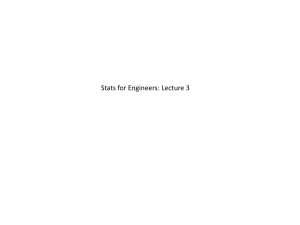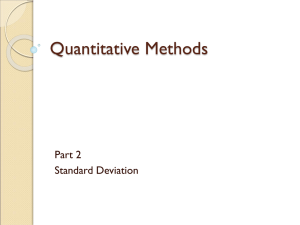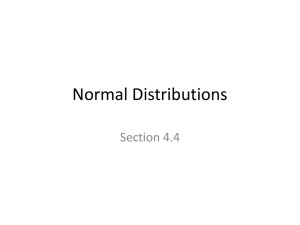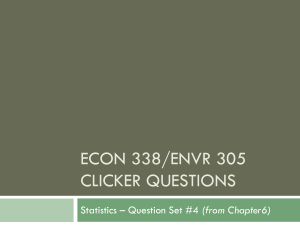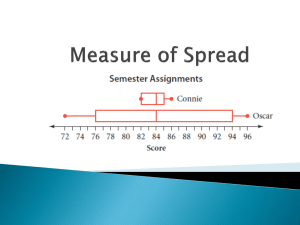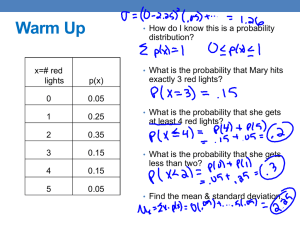Class 12 Notes
advertisement
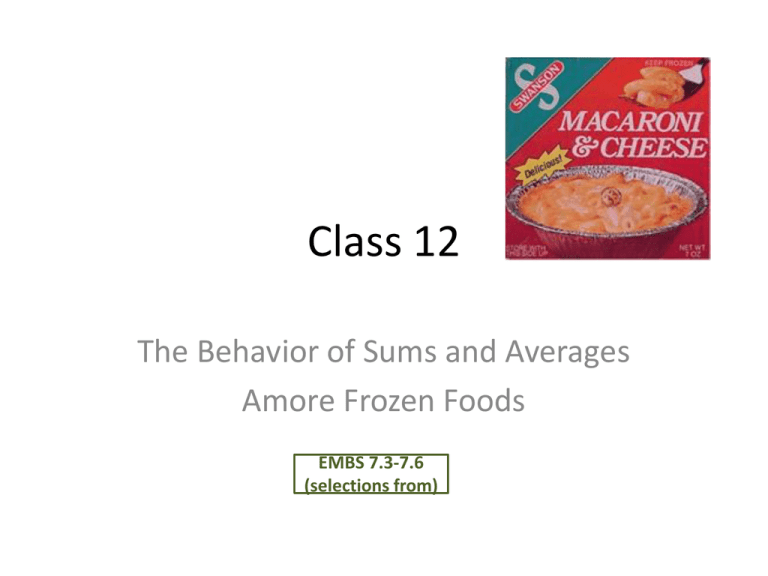
Class 12 The Behavior of Sums and Averages Amore Frozen Foods EMBS 7.3-7.6 (selections from) Review Class 11. chi-squared test of independence • • • • • H0: The Categorical variables are independent Ha: They are not. Pivot Table to create contingency table. Excel to create Expected Counts CHITEST() to calculate p-value. – or Excel to get distances and calculated chisquared statistic, =chidist with dof = (#rows1)(#col-1) to get p-value There is often another way • H0: Athlete and HSStat are independent • H0: P1=P2 – P1 is probability an athlete took HSStat – P2 is the probability a non-athlete took HSStat • You can use the method of section 11.1 to test H0. (check out equation 11.7 to see what’s involved) – And you get exactly the same p-value!! • So, the chi-squared test of independence tests the equality of two probabilities (for a 2x2) and more! That’s why we learned it. Amore • At a target of 8.22, Amore’s filling machine fills mac and cheese tins with an amount N(8.22,0.22) – Resulting in about 16% of tins (pies) being underweight • The FDA requires Amore to test each 20-minute batch using a random sample of five tins. The entire batch must be rejected if the 5-pie sample averages less than 8 ounces. • What is the probability a batch will be rejected? We know how many sample pies will be underfilled…. • Binomial(n=5,p=.16) assuming pie weights are independent. • E(number underfilled) = n*p = 5*.16 = 0.8 • Var(number underfilled) = n*p*(1-p) = 0.672 • Std dev (number underfilled) = 0.820 0.45 0.4 Probability 0.35 n is too small to use the normal approximation 0.3 0.25 0.2 0.15 0.1 0.05 0 01 21 32 43 # Sample Pies Underfilled 54 56 But the fate of the batch rests on the total (average) weight of the five sampled pies. We need to figure out what the probability distribution of either the total or the average of five is. For Amore…. We can work our problem either way. 𝑇𝑜𝑡𝑎𝑙 = 𝑋1 + 𝑋2 + 𝑋3 + 𝑋4 + 𝑋5 𝑋1 + 𝑋2 + 𝑋3 + 𝑋4 + 𝑋5 𝑋= 5 “X-bar” The sample mean The sample mean is just the total times 0.2. The X’s are independent and identically 8.22, distributed N(10.2,.22) random variables 𝑇𝑜𝑡𝑎𝑙 = 𝑋1 + 𝑋2 + 𝑋3 + 𝑋4 + 𝑋5 The Distribution of (Total) = E(Total) = Var(Total) = Standard Deviation (Total) = Means and Variances nicely Add. Adding standard deviations is very bad. The X’s are independent and identically distributed N(μ,σ) random variables 𝑇𝑜𝑡𝑎𝑙 = 𝑋1 + 𝑋2 + 𝑋3 + … + 𝑋𝑛 The Distribution of (Total) = Normal E(Total) = n*μ Var(Total) = n*σ2 Standard Deviation (Total) = 𝑛𝜎 Means and Variances nicely Add. Adding standard deviations is very bad. P(reject Batch) = P(Total<40) = NORMDIST(40,5*8.22,5^.5*.22,true) = 0.013 The X’s are independent and identically distributed N(μ,σ) random variables 𝑋1 + 𝑋2 + 𝑋3 + … + 𝑋𝑛 𝑋= 𝑛 The Distribution of (𝑋 ) = E(𝑋 ) = Normal μ Var(𝑋 ) = σ2/n Standard Deviation (𝑋 ) = 𝜎/ 𝑛 Means and Variances nicely Add. Adding standard deviations is very bad. P(reject Batch) = P(𝑋<8) = NORMDIST(8,8.22,.22/5^.5,true) = 0.013 The standard deviation of a sample mean (𝑋) Aka “the standard error of the sample mean” A standard ERROR is some other standard deviation divided by 𝑛 somehow. 𝜎 𝜎𝑋 = 𝑛 𝜎 𝑋𝑛 ~𝑁(𝜇, ) 𝑛 (7.3) The formulas hold for n=1 and n=∞ and n’s in between. The distribution of a sample mean Assumes independent, identically distributed Normal random variables. 𝜎 𝑋𝑛 ~𝑁(𝜇, ) 𝑛 Illustration. The lorex fill test data Illustration. The lorex fill test data 0.158 5 = Small Schools are Better? Did Bill Gates waste a billion dollars because he failed to understand the formula for the standard deviation of the sample mean? The Gates Foundation certainly spent a lot of money, along with many others, pushing for smaller schools and a lot of the push came because people jumped to the wrong conclusion when they discovered that the smallest schools were consistently among the best performing schools. Small School dominate the “top 25” ….and the bottom! In recent years Bill Gates and the Gates Foundation have acknowledged that their earlier emphasis on small schools was misplaced. He should have taken “Statistics in Business” The X’s are independent and identically distributed N(μ,σ) random variables 𝑇𝑜𝑡𝑎𝑙 = 𝑋1 + 𝑋2 + 𝑋3 + … + 𝑋𝑛 The Distribution of (Total) = Normal E(Total) = n*μ Var(Total) = n*σ2 Standard Deviation (Total) = 𝑛𝜎 Means and Variances nicely Add. Adding standard deviations is very bad. The X’s are independent and identically distributed N(μ,σ) random variables 𝑇𝑜𝑡𝑎𝑙 = 𝑋1 + 𝑋2 + 𝑋3 + … + 𝑋𝑛 The Distribution of (Total) = E(Total) = Var(Total) = Standard Deviation (Total) = Means and Variances nicely Add. Adding standard deviations is very bad. The X’s are independent and identically distributed N(μ,σ) random variables 𝑇𝑜𝑡𝑎𝑙 = 𝑋1 + 𝑋2 + 𝑋3 + … + 𝑋𝑛 The Distribution of (Total) = ?? E(Total) = μ1 + μ2 + … μn Var(Total) = σ21+ σ22+…. σ2n Standard Deviation (Total) = 𝑉𝑎𝑟 Means and Variances nicely Add. Adding standard deviations is very bad. Illustration: Suppose Wunderdog did five sports Sport 1 2 3 4 5 Total n 149 85 133 209 311 887 Number correct if guessing X1 X2 X3 X4 X5 sum of the Xs Means and Variances nicely add. Adding standard deviations is very bad. Expected # correct Variance 74.5 37.25 42.5 21.25 66.5 33.25 104.5 52.25 155.5 77.75 443.5 221.75 Std Dev 6.10 4.61 5.77 7.23 8.82 14.89 Illustration: Suppose Wunderdog did five sports Sport 1 2 3 4 5 Total n 149 85 133 209 311 887 Number correct if guessing X1 X2 X3 X4 X5 sum of the Xs Means and Variances nicely add. Adding standard deviations is very bad. Expected # correct Variance 74.5 37.25 42.5 21.25 66.5 33.25 104.5 52.25 155.5 77.75 443.5 221.75 Std Dev 6.10 4.61 5.77 7.23 8.82 14.89 =[887*.5*.5]^.5 =887*.5 =887*.5*.5 The Binomial Distribution “knows” that means and variances add. Example Problem EMBS 40 p 306. • A large BW survey of MBA’s ten years out found mean dining out spending to be $115.5 (per week) and population standard deviation of $35. You will do a follow-up study and survey a random sample of 40 of the MBA alums. – What sample mean will you get? – What is the probability your sample mean will be within $10 of the population mean? – What is the probability your sample mean will be less than $100? Summary • If we know the X’s are independent, identically distributed N(μ,σ) random variables… – The total of n X’s will be N(nμ, 𝑛σ) – The sample mean of n X’s is written as 𝑋𝑛 – 𝑋𝑛 will be N(μ, σ/ 𝑛) • Means and variances nicely add (if the X’s are independent). Adding standard deviations is very bad. – The BINOMIAL knows this….. Exam1 • Complete answers have been posted • The Binomial works for small n. – P(Cubs Win) = BINOMDIST(3,3,.5,false) – P(2Gin4) = BINOMIDIST(2,4,p,false) • Whether p is 0.5 or 0.48 – P(2P l noD) = BINOMDIST(2,2,.2,false) – P(1P l noD) = BINOMDIST(1,2,.2,false) – P(0P l noD) = BINOMDIST(0,2,.2,false) – #correctly filled is B(n=144,p=.92775)

